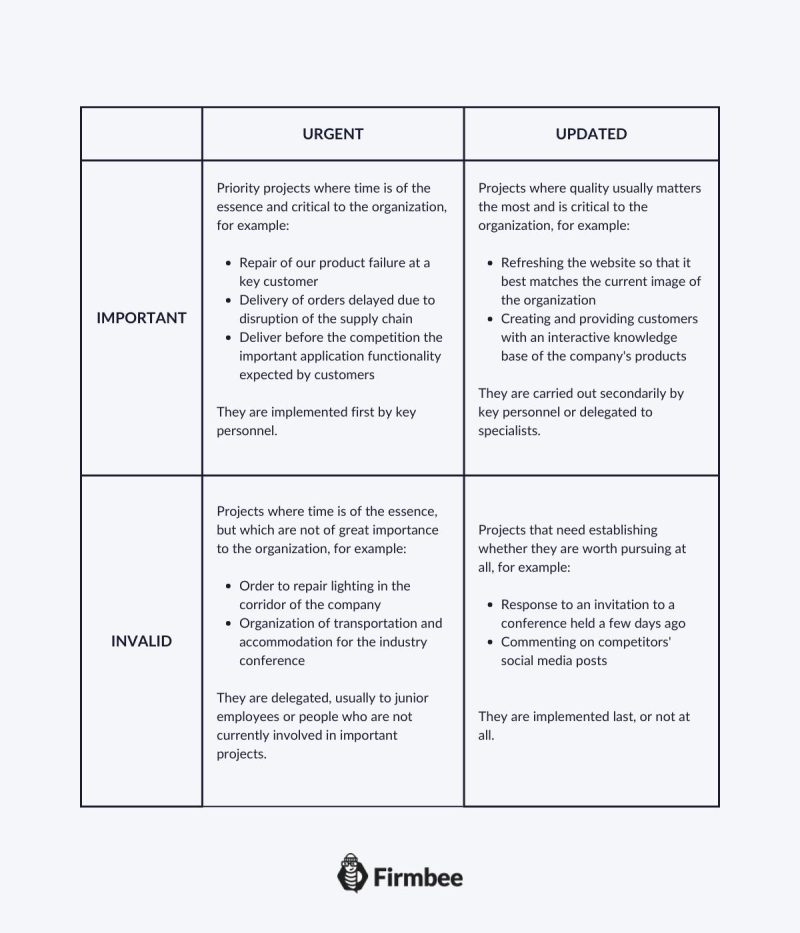In today’s article, we will talk about the prioritization of projects. Is it more important to embark on a risky project that can quickly yield a large profit? Or is it more important to complete the development of solutions that will potentially bring lower but long-term profits and are in the final stages of implementation? Many organizations have numerous projects going on simultaneously. How do you get down to prioritizing them with limited resources?
Prioritization of projects – table of contents:
- Prioritization of projects – introduction
- The Eisenhower Matrix
- moSCoW
- DICE
- Prioritization of projects – summary
Prioritization of projects – introduction
In the following text, we will look at the most popular methods that facilitate decision-making for the prioritization of projects – both those conducted independently and those belonging to a program or portfolio of projects. We will discuss the Eisenhower matrix, applied not only to prioritize projects, but also the tasks carried out in them. We will also take a closer look at the frequently used MoSCoW method created by Dai Clegg, as well as the DICE model invented in the mid-’90s at the Boston Consulting Group.
The Eisenhower Matrix
The Eisenhower matrix allows prioritizing projects by placing them in a space defined by two axes – what is urgent and what is important. There is a common chart to feature them:

moSCoW
Oracle became the pioneer of applying the MoSCoW technique. It is also mentioned as an effective prioritization scheme in the latest Project Management Body of Knowledge (PMBOK) alongside multi-criteria analysis. It divides projects into four categories:
- Must-haves – that is, projects to complete as they are crucial to the very operation of the company; these belong to such projects as establishing security and defining access rights in the company’s cloud, preparing financial statements and reports for an investor, or implementing solutions at a key client,
- Should-want – i.e., those that should get implemented, because neglecting them could worsen the company’s performance; this could be, for example, changing its headquarters to a more convenient location, or entering a new sales platform that is gaining popularity,
- Could-have – that is, projects to implement “if time permits” because they are more likely to positively affect the company; an example of a project in this category might be participation in an industry event, or preparing a competition for contractors,
- Will not have – that is, those that may be implemented in the future, but are not currently on the priority list.
DICE
The DICE method translates the priorities assigned to projects into numerical values and features in more than 1,000 large organizations worldwide. The DICE acronym consists of the following components:
- D (Duration) – the duration of the project, which is assigned the following values:
- 1 – when the project lasts less than 2 months
- 2 – when the project lasts 2-4 months
- 3 – when the project lasts 4-8 months
- 4 – when the project lasts more than 8 months
- I (Team Performance Integrity) – the ability of the team, with particular emphasis on the Project Manager, to successfully execute the project, which is awarded points of value:
- 1 – very good
- 2 – good
- 3 – average
- 4 – low
- C (Commitment) – support levels, consisting of two components
- C1 – visible support of the project from the sponsor or the board of directors
- C2 – support from people affected by the implementation of the project, where the following values correspond to each of them:
- 1 – clearly communicated support
- 2 – fairly clear support
- 3 – neutral posture
- 4 – clear resistance
- E (Effort) – the effort required to implement the project, beyond the daily duties of running the company, where the values look like this:
- 1 – less than 10% of additional circulation
- 2 – 10-20% additional circulation
- 3 – 20-40% additional circulation
- 4 – more than 40% of additional circulation
The value of DICE is calculated using the following formula: D + (2 x I) + (2 x C1) + C2 + E
Depending on the score, you can determine the likelihood of whether the planned project will be successful, and thus whether it is worth placing high on the priority list:
- 7 – 14 – win zone – the project has a very good chance of implementation
- 14 – 17 – danger zone – the project has some chance of success
- above 17 – zone of despair – the outcome of the project is difficult to predict or the project is unlikely to succeed.

Prioritization of projects – summary
The project prioritization methods outlined are, of course, not always available for project selection and ranking. Many organizations do not apply formalized prioritization methods such as DICE, and in some the opinion of an individual guided solely by his own opinions is decisive. However, especially when several critical and high-risk projects are being considered to start or continue at the same time, prioritization tools are worth using.
If you like our content, join our busy bees community on Facebook, Twitter, LinkedIn, Instagram, YouTube, Pinterest,
Author: Caroline Becker
As a Project Manager, Caroline is an expert in finding new methods to design the best workflows and optimize processes. Her organizational skills and ability to work under time pressure make her the best person to turn complicated projects into reality.
The most important questions
-
What other project prioritization methods are common in business?
Among other methods popular for companies that run multiple projects simultaneously, it is worth mentioning Q-sort. It involves evaluating projects in pairs according to one specific criterion. For example, answering the question of which of two projects will be more important for the organization to implement. This allows you to sort them from most important to least important.
-
Can I use the Eisenhower matrix to prioritize tasks in a project?
Yes, the matrix is popular in prioritizing tasks in the project backlog, for example, when working in Scrum or Scrumban.
Getting started with project management:
- What is a project?
- What is project management?
- How to manage projects?
- Project management methods
- Types of projects
- 4 examples of projects
- Prioritization of projects
- Areas of project activity
- Definition of success in project management
- Why use project management software?
- How to choose the best project management software?
- Overview of project management software
- Project life cycle
- What is the project vision for?
- Project goal. What is it and how to define it well?
- Project initiation phase - what to pay attention to?
- The domain of planning in project management
- What is a project schedule and what is it for?
- How to use milestones in a project?
- Project execution
- How to prepare a successful project contingency plan?
- Importance of project closure
- Project failure. 5 reasons why projects fail
- 4Ps of management: project, product, program and portfolio
- Most important tasks and responsibilities of the Project Manager
- Most useful project manager skills
- How to become a project manager?
- 5 books every project manager should read
- How to set up a project team?
- Work breakdown structure - how to delegate work in a project?
- How to lead a team during hybrid work?
- Challenges project managers face when working with a team
- Types of project meetings
- Project monitoring. What parameters to watch?
- How to write a compelling
- How to define the scope of a project and avoid scope creep?
- Feasibility study – can we implement this project?
- Risk analysis in projects and tools to facilitate it
- How to create a project charter?
- What is a stakeholder register?
- Gantt chart in project management planning
- How to create a project budget?
- Time management in project
- How to create a project risk register?
- Project risk management strategies
- Project marketing
- Sources and areas of change in the project
- Project management change models
- What's after Agile? Methods in project management


















